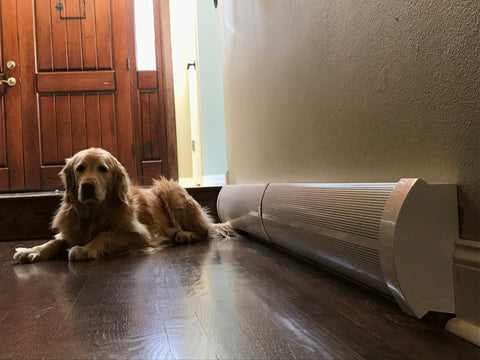Forced Air vs Hydronic Baseboard Heating

Heating a home with a hot water based heating system has numerous advantages over the more popular forced air type of heating. Lately however, hot water systems, baseboard in particular, have seen a significant decline in the number of installations in new homes.
Drawing a comparison between these two forms of home heating is worthy when one considers that easy slip-on Baseboarders are designed to breathe new life into existing ugly, old, yet perfectly functional hot water baseboard heaters. In a world full of low quality consumer goods, too many people are willing to just discard the old product and buy something new.
Hot water baseboard heaters shouldn't be one of them. What many don't realize is that hot water baseboard heaters will easily outlast their owners with only a minimal amount of regular maintenance. It's just the covers that tend to get needy as they rust away and suffer from easy denting and general ugliness. Baseboarders solve these problems.
So let's look at some reasons why old hydronic baseboard heaters are worth renovating and new construction projects should opt for boiler heat over forced air from a furnace.

Efficiency of Energy Transfer
Winner: Hydronic heating
Without getting into fancy BTU thermal transfer formula, it is a fact that the amount of heat energy that one cubic inch of water can transport is many times greater than the amount of heat energy a cubic inch of air can carry.
Architectural Design
Winner: Hydronic heating
Homes that are outfitted with forced air heating systems require large amounts of interior space for duct work. As stated above, the volume required to transport heated air means a much larger amount of space has to be dedicated for ducts in comparison to the easily tucked away 7/8" round copper pipe carrying hot water. Houses with duct work are full of low ceilings and other design compromises in order to accommodate the infrastructure.

Maintenance
Winner: Hydronic heating
Forced air systems push air through duct work. Over time the ducts will experience an accumulation of dust and other particles and must be cleaned on a regular basis. Cleaning is normally done by a duct cleaning company with special equipment. Hydronic baseboard heat systems can use the same water in the system for years.
The water in the copper pipes will eventually turn black as it absorbs the minerals in the copper (just like copper roofs turn to a dark green after a few years) but does not require changing. The only maintenance on hydronic systems is the occasional, perhaps annual, bleeding of air in the pipes when the heat is first turned on in the fall and a simple vacuuming of the heating element.
Year Round Usage
Winner: Forced air heating
Using water to transport heat energy works great. Unfortunately it does not work in the reverse as cold water flowing through copper would produce massive amounts of condensation and ultimately water damage. This is the big advantage for forced air; cold air can easily be pushed through the system of ducts in the hot summer months. An additional air conditioning unit must be purchased in addition to the furnace, but once in place the ducts can deliver comfortable heat or cooling year round.
Need help? Go to Choosing the Right Heating System--a Comparison

Health Considerations
Winner: Hydronic heating
Hot water baseboard heaters utilize the natural airflow in the room to evenly distribute heat. This is known as convection air current heating. This process does not introduce any new particulate into the air.
Forced air blows air from a vent that originates from a furnace that takes air from inside the home. Although furnace air filters are used to keep the air clean, most cannot effectively filter out very small particles such as those that cause seasonal allergies.
Noise
Winner: Forced air heating
Most modern furnaces today are efficient and quiet. Unfortunately hydronic heat has a reputation for being noisy due to the soft copper expanding and contracting constantly when in use. Although physical contact with the joists and studs that the copper runs through can be avoided with proper installation techniques, it remains one of the few complaints for this type of heating. The use of PEX tubing, a modern substitute for copper pipe, is one way of avoiding this noise problem.

Overall Cost
Winner: Varies
There are just too many variables to compare costs. Differences in the cost of equipment can vary dramatically throughout the country. Fuel type, boiler/furnace efficiency and local skilled labor rates also make this a very difficult comparison.
Compare hydronic vs electric baseboard heaters.
These are just a few things to keep in mind whether you're planning to build a new home or browsing the MLS for the right property. While some may see hot water baseboard heaters as outdated, hydronic baseboard systems deserve credit for their performance. And with the addition of Baseboarders, they'll earn appreciation not just for how they work—but for how they look.

